Care When It Counts: Establishing Trauma-Sensitive Care as a Preventative Approach for 0–3-Year-Old Children Suffering from Trauma and Chronic Stress
Abstract
1. Introduction
The Present Study
2. Materials and Methods
2.1. Participants and Procedure
2.1.1. Living Lab Method
2.1.2. Training Intervention
2.2. Measures
2.3. Analyses
3. Results
3.1. Living Lab Method
3.1.1. Chapter 1: The Meaning of Adverse Childhood Experiences and Trauma
3.1.2. Chapter 2: The Impact of Trauma on Young Children
3.1.3. Chapter 3: How Trauma-Sensitive Care Is Useful When Caring for Young Children
3.1.4. Chapter 4: How to Implement Trauma-Sensitive Care in a Care Setting for Young Children
3.1.5. Chapter 5: Supplementary Materials
3.2. Training Intervention
4. Discussion
Supplementary Materials
Author Contributions
Funding
Institutional Review Board Statement
Informed Consent Statement
Data Availability Statement
Acknowledgments
Conflicts of Interest
References
- Felitti, V.J.; Anda, R.F.; Nordenberg, D.; Williamson, D.F. Adverse childhood experiences and health outcomes in adults: The Ace study. J. Fam. Consum. Sci. 1998, 90, 31. [Google Scholar]
- Bellis, M.A.; Hughes, K.; Ford, K.; Rodriguez, G.R.; Sethi, D.; Passmore, J. Life course health consequences and associated annual costs of adverse childhood experiences across Europe and North America: A systematic review and meta-analysis. Lancet Public Health 2019, 4, e517–e528. [Google Scholar] [CrossRef] [PubMed]
- Kerker, B.D.; Zhang, J.; Nadeem, E.; Stein, R.E.; Hurlburt, M.S.; Heneghan, A.; Landsverk, J.; McCue Horwitz, S. Adverse Childhood Experiences and Mental Health, Chronic Medical Conditions, and Development in Young Children. Acad. Pediatr. 2015, 15, 510–517. [Google Scholar] [CrossRef] [PubMed]
- Lund, J.I.; Toombs, E.; Radford, A.; Boles, K.; Mushquash, C. Adverse Childhood Experiences and Executive Function Difficulties in Children: A Systematic Review. Child Abus. Negl. 2020, 106, 104485. [Google Scholar] [CrossRef] [PubMed]
- Oral, R.; Ramirez, M.; Coohey, C.; Nakada, S.; Walz, A.; Kuntz, A.; Benoit, J.; Peek-Asa, C. Adverse childhood experiences and trauma informed care: The future of health care. Pediatr. Res. 2016, 79, 227–233. [Google Scholar] [CrossRef]
- Perry, B.D. The Neuroarcheology of Childhood Maltreatment: The Neurodevelopmental Costs of Adverse Childhood Events. In The Cost of Maltreatment: Who Pays? We All Do; Franey, K., Geffner, R., Falconer, R., Eds.; Family Violence and Sexual Assault Institute: San Diego, USA, 2001; pp. 15–37. [Google Scholar]
- Buss, C.; Entringer, S.; Moog, N.K.; Toepfer, P.; Fair, D.A.; Simhan, H.N.; Heim, C.M.; Wadhwa, P.D. Intergenerational Transmission of Maternal Childhood Maltreatment Exposure: Implications for Fetal Brain Development. J. Am. Acad. Child Adolesc. Psychiatry 2017, 56, 373–382. [Google Scholar] [CrossRef]
- Shonkoff, J.P.; Garner, A.S.; Committee on Psychosocial Aspects of Child and Family Health; Committee on Early Childhood, Adoption, and Dependent Care; Section on Developmental and Behavioral Pediatrics. The lifelong effects of early childhood adversity and toxic stress. Pediatrics 2012, 129, e232–e246. [Google Scholar] [CrossRef]
- Harstad, E.; Albers-Prock, L.M. Caring for Your Baby and Young Child: Birth to Age 5, Fifth Edition. J. Dev. Behav. Pediatr. 2011, 32, 102. [Google Scholar] [CrossRef]
- Kitzmann, K.M.; Gaylord, N.K.; Holt, A.R.; Kenny, E.D. Child witnesses to domestic violence: A meta-analytic review. J. Consult. Clin. Psychol. 2003, 71, 339–352. [Google Scholar] [CrossRef]
- United Nationals Children’s Fund. A Familiar Face. Violence in the Lives of Children and Adolescents; United Nationals Children’s Fund: New York, NY, USA, 2017. [Google Scholar]
- Bowlby, J. Attachment. In Attachment and Loss; Basic Books: New York, NY, USA, 1982. [Google Scholar]
- Bowlby, J. The nature of the child’s tie to his mother 1. In Influential Papers from the 1950s; Routledge: Abingdon-on-Thames, UK, 2018; pp. 222–273. [Google Scholar] [CrossRef]
- McConnico, N.; Boynton-Jarrett, R.; Bailey, C.; Meghna, N. A framework for trauma-sensitive schools. In Zero to Three: Chronic Stress and Complex Trauma, 5th ed.; Zero to Three: Washington, DC, USA, 2016; Volume 36, pp. 36–44. [Google Scholar]
- Singh, B.S.K.; Danckaerts, M.; Bergh, B.R.H.V.D. Helping Families of Infants with Persistent Crying and Sleep Problems in a Day-Clinic. Front. Psychiatry 2021, 12, 1389. [Google Scholar] [CrossRef]
- Dierickx, S.; Bisagno, E.; Varga-Sabján, D.; Morva, D.; Linde-Ozola, Z.; László, N.; Cadamuro, A.; Mosleh, D.B.; Rózsa, M.; De Fazio, G.L.; et al. Trauma-informed care in childcare organisations to support children exposed to child maltreatment: Joint conclusions of four European countries. Child Abus. Rev. 2023, in press. [CrossRef]
- Harper, N.S. Trauma-Informed Care for Children and Adolescents. Pediatr. Ann. 2019, 48, e255–e256. [Google Scholar] [CrossRef] [PubMed]
- Bisagno, E.; Cadamuro, A.; Dierickx, S.; Mosleh, D.B.; Linde-Ozola, Z.; Kandāte, A.; Varga-Sabjan, D.; Morva, D.; Laszlo, N.; Rozsa, M.; et al. A European comparison of screening and referral by childcare professionals of maltreatment in children aged 0–3: A wild goose chase or maybe not. Child Abus. Rev. 2023, in press. [CrossRef]
- Huang, L.N.; Flatow, R.; Biggs, T.; Afayee, S.; Smith, K.; Clark, T.; Blake, M. SAMHSA’s Concept of Truama and Guidance for a Trauma-Informed Approach; Substance Abuse and Mental Health Services Administration (SAMHSA): Rockville, MD, USA, 2022. [Google Scholar]
- Hawley, T. Starting Smart: How Early Experiences Affect Brain Development; Ounce of Prevention Fund: Chicago, IL, USA, 2000. [Google Scholar]
- Australian Childhood Foundation. Making Space for Learning: Trauma Informed Practice in Schools; Australian Childhood Foundation: Richmond, VIC, Australia, 2010. [Google Scholar]
- Holmes, C.; Levy, M.; Smith, A.; Pinne, S.; Neese, P. A Model for Creating a Supportive Trauma-Informed Culture for Children in Preschool Settings. J. Child Fam. Stud. 2015, 24, 1650–1659. [Google Scholar] [CrossRef] [PubMed]
- Shaw, R.J.; Deblois, T.; Ikuta, L.; Ginzburg, K.; Fleisher, B.; Koopman, C. Acute Stress Disorder Among Parents of Infants in the Neonatal Intensive Care Nursery. Psychosomatics 2006, 47, 206–212. [Google Scholar] [CrossRef]
- Schuurman, D.; de Marez, L.; Ballon, P. Living Labs: A systematic literature review. 2015. In Open Living Lab Days, Proceedings; Open Living Lab Days: Istanbul, Turkey, 2015; Available online: http://hdl.handle.net/1854/LU-7026155 (accessed on 30 March 2023).
- Bisagno, E.; Cadamuro, A.; Serafine, D.; Dima, B.M.; Anne, G.; Zane, L.O.; Annija, K.; Dóra, V.S.; Dorottya, M.; Noémi, L.; et al. The development of a screening tool for childcare professionals to detect and refer infant and toddler maltreatment and trauma: A tale of four countries. Children 2023, 10, 858. [Google Scholar] [CrossRef]
- Siegel, D. The Developing Mind; Guilford: New York, NY, USA, 1999. [Google Scholar]
- Perry, B.D.; Ablon, J.S. CPS as a Neurodevelopmentally Sensitive and Trauma-Informed Approach. In Collaborative Problem Solving; Springer Nature: Cham, Switzerland, 2019; pp. 15–31. [Google Scholar] [CrossRef]
- Fonagy, P. The developmental roots of violence in the failure of mentalization. In Matter of Security: The Application of Attachment Theory to Forensic Psychiatry and Psychotherapy; Jessica Kingsley Publishers: London, UK, 2003; Volume 13, pp. 13–56. [Google Scholar]
- Brend, D.M.; Sprang, G. Trauma-Informed Care in Child Welfare: An Imperative for Residential Childcare Workers. Int. J. Child Adolesc. Resil. 2020, 7, 154–165. [Google Scholar] [CrossRef]
- Cusick, S.E.; Georgieff, M.K. The Role of Nutrition in Brain Development: The Golden Opportunity of the “First 1000 Days”. J. Pediatr. 2016, 175, 16–21. [Google Scholar] [CrossRef]
- Ward, L.G. Trauma-Informed Perinatal Healthcare for Survivors of Sexual Violence. J. Périnat. Neonatal Nurs. 2020, 34, 199–202. [Google Scholar] [CrossRef]
- Reeves, E. A Synthesis of the Literature on Trauma-Informed Care. Issues Ment. Health Nurs. 2015, 36, 698–709. [Google Scholar] [CrossRef]
- Koechlin, H. Effects of Childhood Life Events on Adjustment Problems in Adolescence: A Longitudinal Study. J. Dev. Behav. Pediatr. 2018, 39, 629–641. [Google Scholar] [CrossRef] [PubMed]
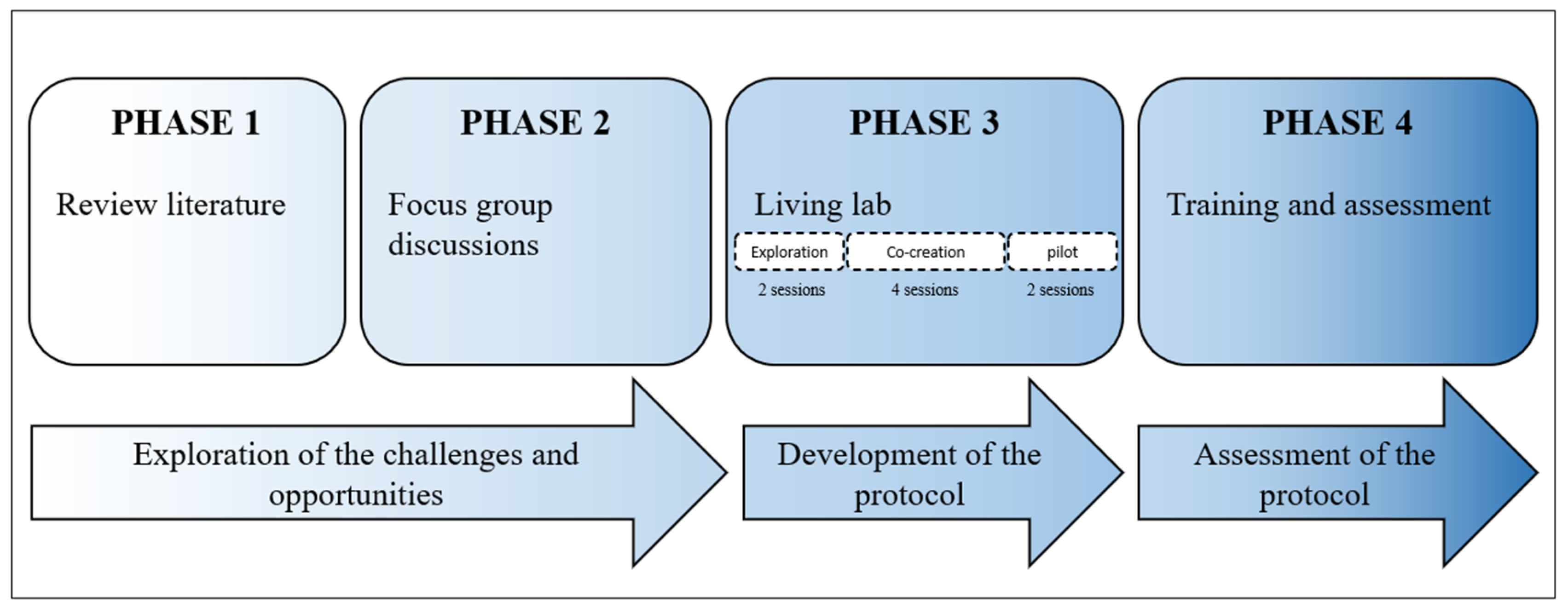
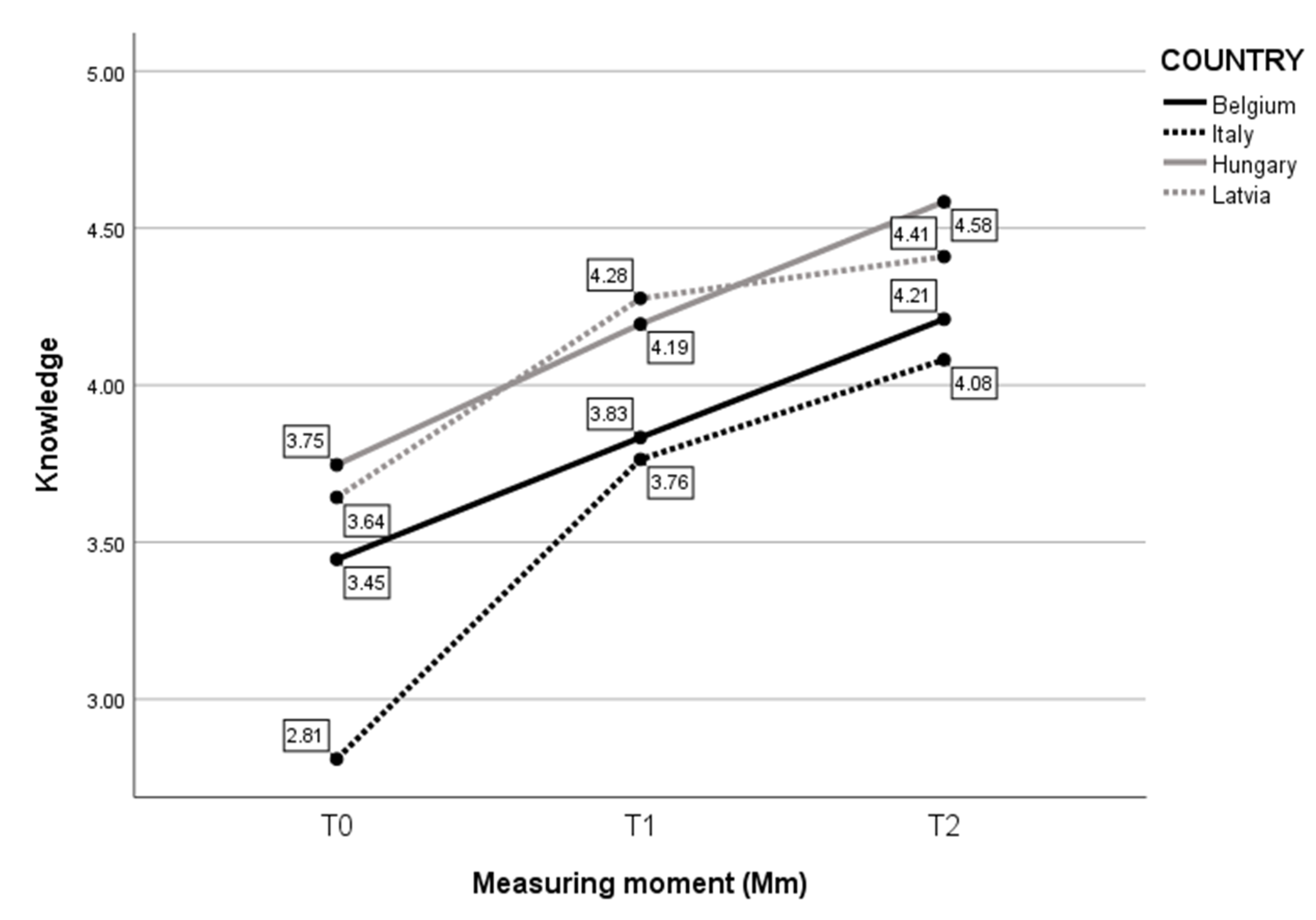
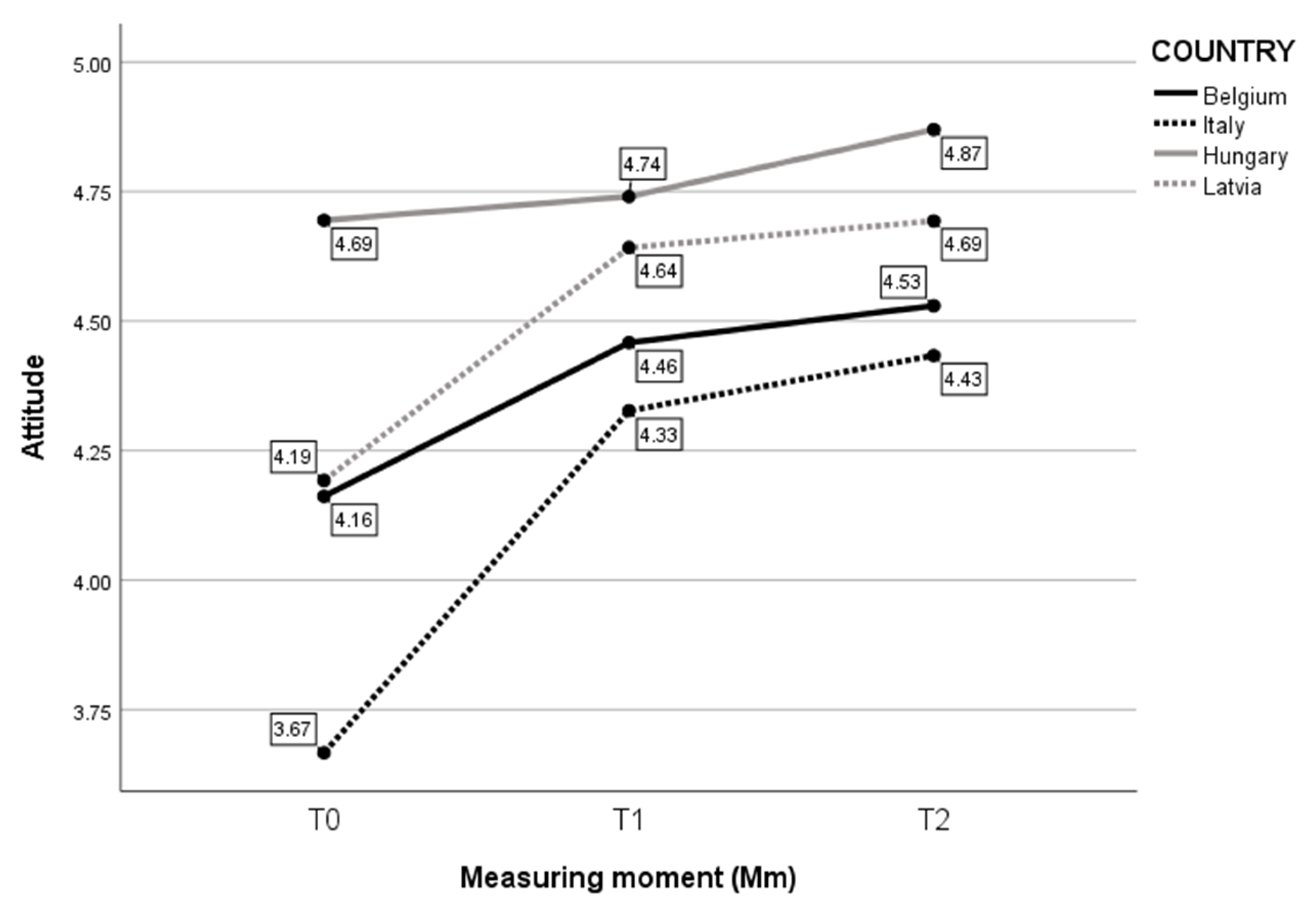
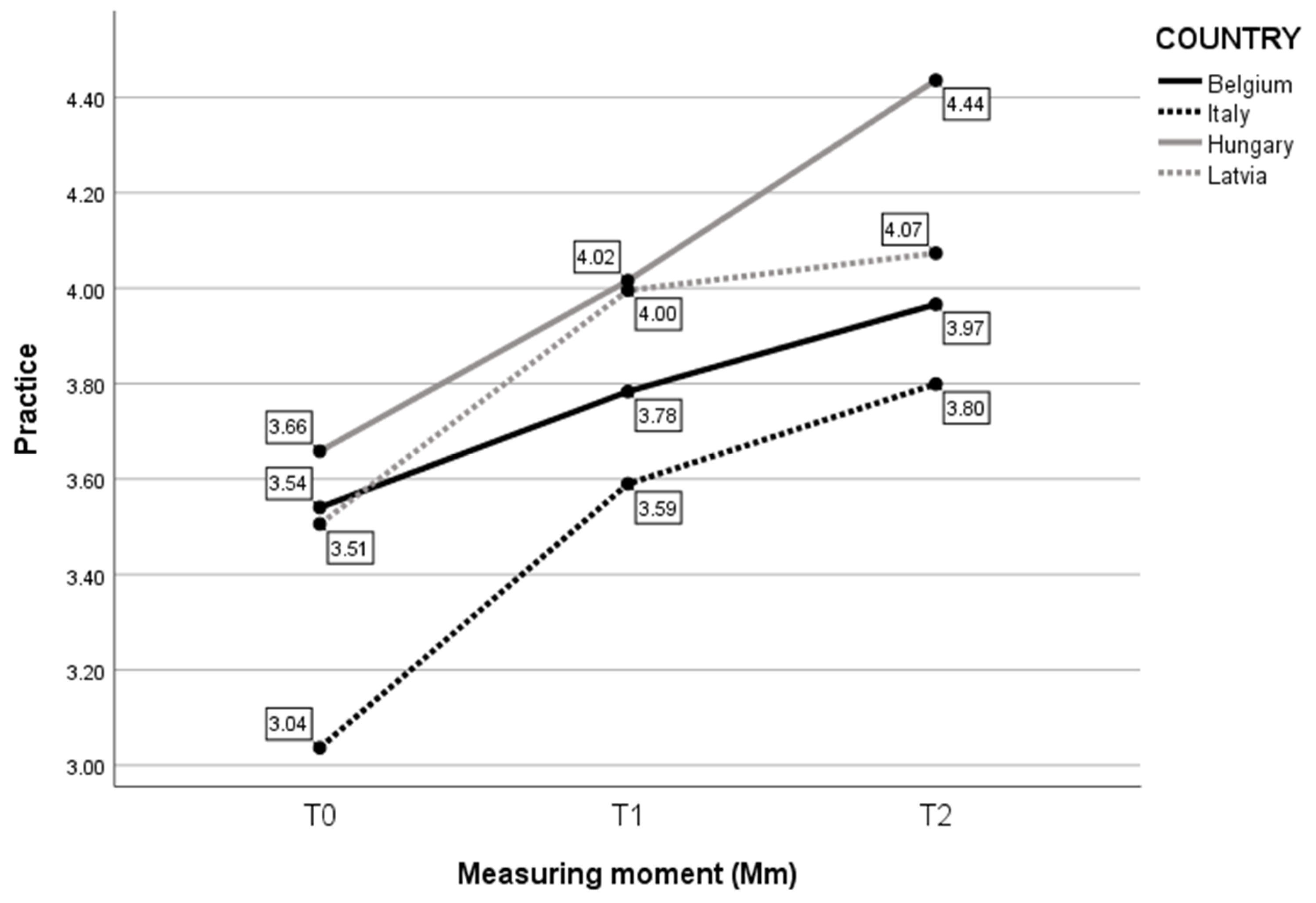
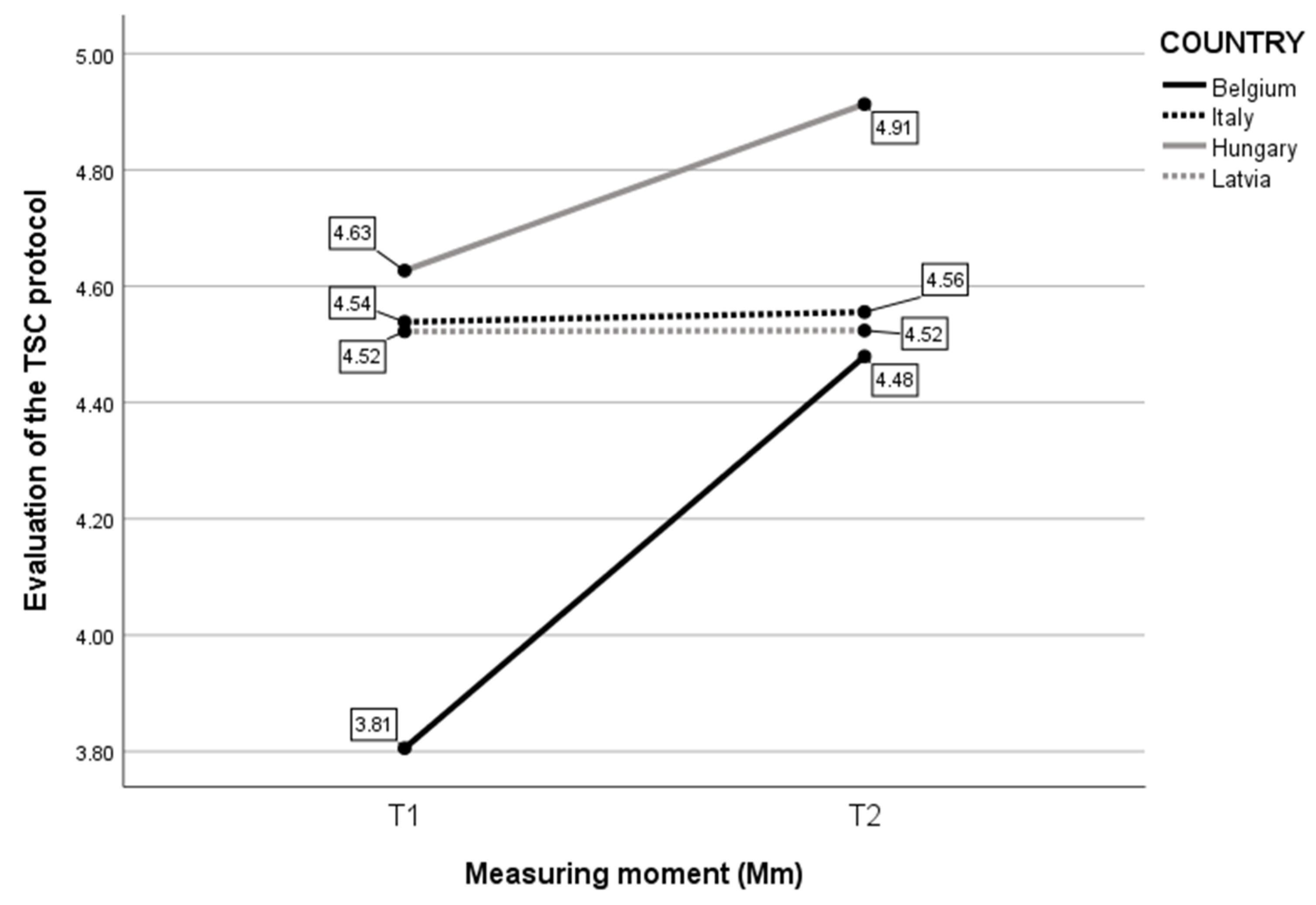
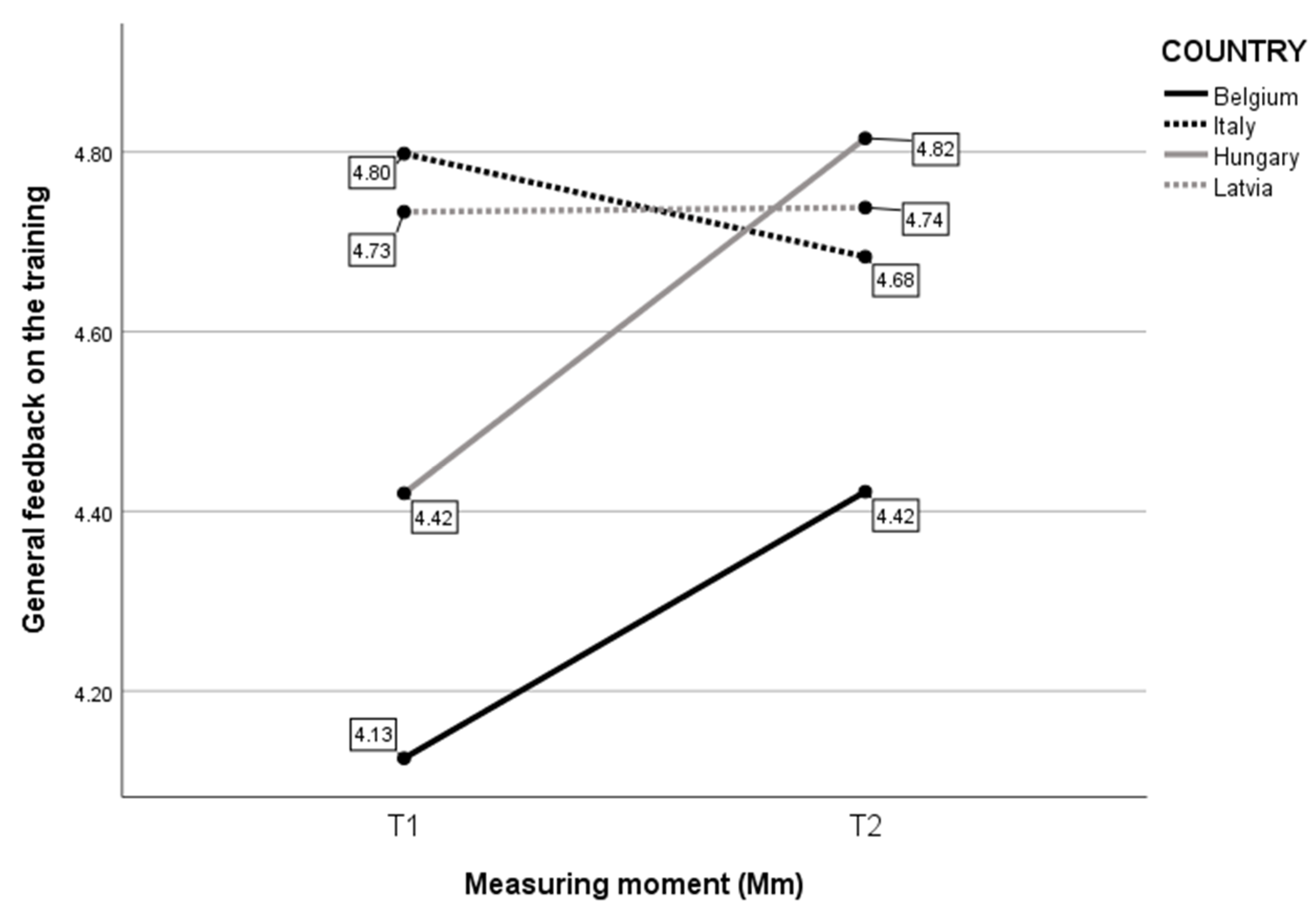
| Project Partner’s Country | T0 | T1 | T2 |
|---|---|---|---|
| Belgium | 17 | 12 | 17 |
| Italy | 30 | 26 | 30 |
| Hungary | 27 | 25 | 23 |
| Latvia | 26 | 30 | 22 |
| Total sample | 100 | 93 | 92 |
| T0 | T1 | T2 | Total | |||||||
|---|---|---|---|---|---|---|---|---|---|---|
| M | SD | M | SD | M | SD | M | SD | n items | alpha | |
| Knowledge | 3.39 | 0.62 | 4.05 | 0.47 | 4.31 | 0.37 | 3.90 | 0.64 | 7 | 0.797 |
| Attitude | 4.17 | 0.60 | 4.56 | 0.46 | 4.62 | 0.41 | 4.44 | 0.54 | 4 | 0.592 |
| Practice | 3.41 | 0.57 | 3.86 | 0.94 | 4.05 | 0.50 | 3.77 | 0.58 | 13 | 0.915 |
| Infant care | 3.05 | 0.75 | 3.65 | 0.67 | 3.94 | 0.61 | 3.54 | 0.78 | 4 | 0.887 |
| Parent interaction | 2.84 | 0.84 | 3.54 | 0.73 | 3.82 | 0.66 | 3.38 | 0.86 | 5 | 0.914 |
| Self-care | 3.58 | 0.65 | 3.90 | 0.69 | 4.16 | 0.61 | 3.87 | 0.69 | 2 | 0.460 |
| Team environment | 4.16 | 0.70 | 4.34 | 0.63 | 4.30 | 0.72 | 4.27 | 0.69 | 2 | 0.701 |
| Evaluation of the TSC protocol | 4.46 | 0.66 | 4.63 | 0.47 | 4.54 | 0.58 | 3 | 0.885 | ||
| General feedback on the training | 4.59 | 0.51 | 4.68 | 0.46 | 4.64 | 0.49 | 4 | 0.869 | ||
Disclaimer/Publisher’s Note: The statements, opinions and data contained in all publications are solely those of the individual author(s) and contributor(s) and not of MDPI and/or the editor(s). MDPI and/or the editor(s) disclaim responsibility for any injury to people or property resulting from any ideas, methods, instructions or products referred to in the content. |
© 2023 by the authors. Licensee MDPI, Basel, Switzerland. This article is an open access article distributed under the terms and conditions of the Creative Commons Attribution (CC BY) license (https://creativecommons.org/licenses/by/4.0/).
Share and Cite
Dierickx, S.; Malisse, L.; Bisagno, E.; Cadamuro, A.; Van Haeken, S.; Wuyts, D.; Linde-Ozola, Z.; Kandãte, A.; Morva, D.; Rozsa, M.; et al. Care When It Counts: Establishing Trauma-Sensitive Care as a Preventative Approach for 0–3-Year-Old Children Suffering from Trauma and Chronic Stress. Children 2023, 10, 1035. https://doi.org/10.3390/children10061035
Dierickx S, Malisse L, Bisagno E, Cadamuro A, Van Haeken S, Wuyts D, Linde-Ozola Z, Kandãte A, Morva D, Rozsa M, et al. Care When It Counts: Establishing Trauma-Sensitive Care as a Preventative Approach for 0–3-Year-Old Children Suffering from Trauma and Chronic Stress. Children. 2023; 10(6):1035. https://doi.org/10.3390/children10061035
Chicago/Turabian StyleDierickx, Serafine, Laura Malisse, Elisa Bisagno, Alessia Cadamuro, Sarah Van Haeken, Dorien Wuyts, Zane Linde-Ozola, Annija Kandãte, Dorottya Morva, Monika Rozsa, and et al. 2023. "Care When It Counts: Establishing Trauma-Sensitive Care as a Preventative Approach for 0–3-Year-Old Children Suffering from Trauma and Chronic Stress" Children 10, no. 6: 1035. https://doi.org/10.3390/children10061035
APA StyleDierickx, S., Malisse, L., Bisagno, E., Cadamuro, A., Van Haeken, S., Wuyts, D., Linde-Ozola, Z., Kandãte, A., Morva, D., Rozsa, M., Gruber, A., Blom, J. M. C., De Fazio, L. G., Mosleh, D. B., Varga-Sabján, D., & Groenen, A. (2023). Care When It Counts: Establishing Trauma-Sensitive Care as a Preventative Approach for 0–3-Year-Old Children Suffering from Trauma and Chronic Stress. Children, 10(6), 1035. https://doi.org/10.3390/children10061035






